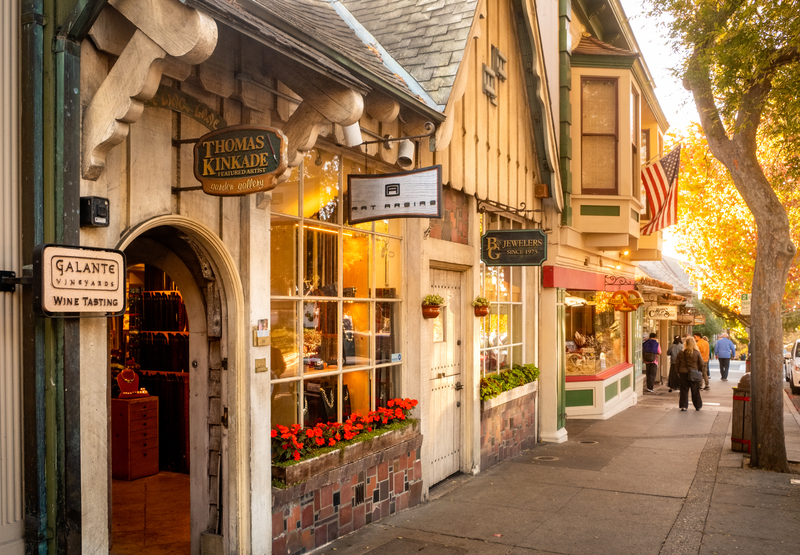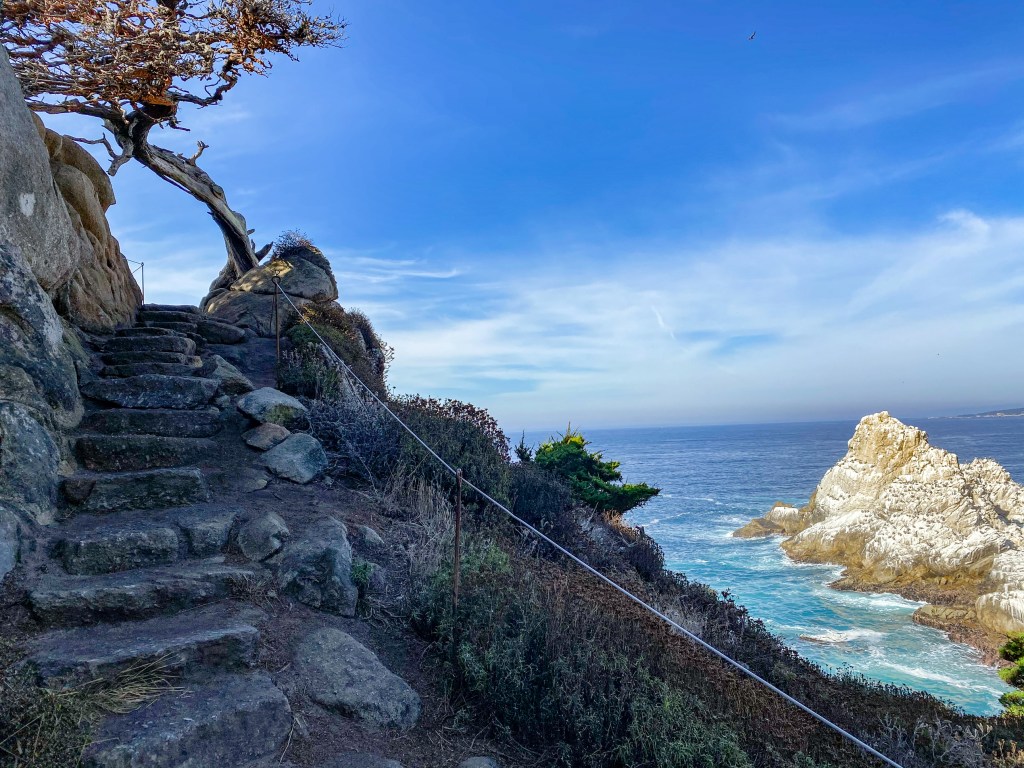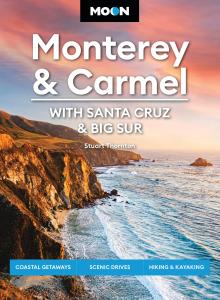What to See in Carmel-by-the-Sea
There are no addresses in Carmel-by-the-Sea (frequently referred to as simply Carmel). There are lots of trees and no streetlights, and street signs are wooden posts with names written vertically, to be read while walking along the sidewalk, rather than driving down the street. There’s little to do at night. These are a few clues as to how this hamlet facing the Pacific Ocean maintains its lost-in-time charm.

Formerly a Bohemian enclave where local poets George Sterling and Robinson Jeffers hung out with literary heavyweights such as Jack London and Mary Austin, Carmel-by-the-Sea is now a popular vacation spot for the moneyed, the artistic, and the romantic. People come to enjoy the small coastal town’s almost European charm: strolling its sidewalks and peering into the windows of upscale shops and art galleries, which showcase the work of sculptors, plein air painters, and photographers. Between the galleries are some of the region’s most revered restaurants. The main thoroughfare, Ocean Avenue, slopes down to Carmel Beach, one of the finest on the Monterey Peninsula.
The old-world charms of Carmel can make it a little confusing for drivers. Because there are no addresses, locations are sometimes given via directions; for example: on 7th Avenue between San Carlos and Dolores Streets; or the northwest corner of Ocean Avenue. The town is compact, laid out on a plain grid system, so you’re better off getting out of your car and walking anyway. Expect to share everything from Carmel’s sidewalks to its restaurants with our canine friends. Carmel is very pro-pup.
Sights
Ocean Avenue
With its wide, clean sidewalks, posh stores, bakeries, and restaurants, Ocean Avenue has a European feel. The main street of downtown Carmel-by-the-Sea can be crowded with humans and their dogs during summer and on holidays, but it is worth a stroll to get a taste of Carmel’s unique personality. The road is four lanes wide with a tree-lined median separating the east- and west-traveling traffic. West of Lincoln Avenue, Ocean Avenue slopes toward the sea at a grade that recalls a ski run. At the end of Ocean Avenue is one of the best places to access Carmel Beach.
Carmel Mission

3080 Rio Rd.; 831/624-1271; www.carmelmission.org; 10am-4pm Wed.-Thurs., 10am-5pm Fri.-Sat., 11:30am-5pm Sun.; adults $13, seniors $10, children $7, children 6 and under free
Founded in 1771, San Carlos Borromeo de Carmelo Mission, more commonly known as the Carmel Mission, encompasses a collection of rambling buildings, living quarters, and courtyard gardens. Notable features of the complex are the restored church, with its gilded altar front and shrine to the Virgin Mary. The site is home to many significant historic artifacts, especially the Convento Museum, where the first library in California is located. Those interested in early California history should make sure to visit the Munras Museum, a building in the back of the complex that showcases artifacts from one of Monterey’s early prominent families. A working Catholic parish remains part of the complex, so be respectful when taking the self-guided tour.
The Carmel Mission is one of 21 California missions built by the Franciscan order—in the process displacing and enslaving the region’s Indigenous peoples—in the 18th and 19th centuries. Father Junípero Serra personally founded nine of them and preferred the Carmel Mission to all his other California missions. He lived, worked, and eventually died here. His grave and an ancillary chapel dedicated to his memory are located on-site. In 2015, when Serra was canonized by Pope Francis, this mission was the site of protests by Native Americans voicing dissent over Serra’s treatment of Indigenous people.
Be sure to check out the mission’s gardens, fountains, and small cemetery, which is home to the gravestone of Old Gabriel, a Native American who is believed to have lived to be 151 years old.
The Carmel Mission does not adequately inform visitors of what the Native Californians endured in the mission system. For more information about the area’s Indigenous people and how they were affected by the arrival of the Spanish, pick up a copy of The Ohlone Way: Indian Life in the San Francisco-Monterey Bay Area.
Tor House
26304 Ocean View Ave.; 831/624-1813; www.torhouse.org; tours 10am, 11am, noon Sat.; adults $15, students $10
Local poet Robinson Jeffers penned nature poems to the uncompromising beauty of Carmel Point and nearby Big Sur. He built this rugged-looking castle on the Carmel coast in 1919, naming it Tor House after its rocky setting, and added the majestic Hawk Tower a year later.
Tor House Foundation volunteer docents lead 75-minute tours of the property that include a walk through the original home, which was hand-built by Jeffers with giant stones. The poet once hosted luminaries like Ansel Adams, Charlie Chaplin, Edna St. Vincent Millay, and Dylan Thomas in the dining room, which offers fine views of Carmel Point and Point Lobos. The highlight of the tour is a visit to Hawk Tower, a four-story stone structure crowned with an open-air turret. Climb up a hidden staircase (not for the claustrophobic) or opt for the outside staircase to reach stunning views of Jeffers’s property and the natural beauty that inspired his best work.
Point Lobos State Natural Reserve

CA-1, 3 mi/4.8 km south of Carmel; 831/624-4909; www.parks.ca.gov and www.pointlobos.org; 8am-30 minutes after sunset daily winter, 8am-7pm daily spring-fall; $10/vehicle
Said to be the inspiration behind the setting of Robert Louis Stevenson’s Treasure Island, Point Lobos State Natural Reserve is a wonderland of coves, hills, and jumbled rocks. The reserve’s Cypress Grove Trail winds through a forest of antler-like Monterey cypress trees that are cloaked in striking red algae.
Half of the reserve is underwater, open for scuba divers who want to explore the 70-ft-high (21.3-m-high) kelp forests located just offshore.
Point Lobos also offers a lesson on the region’s fishing history in the Whaler’s Cabin (9am-5pm daily, staff permitting), a small wooden structure that was built by Chinese fishermen in the 1850s.
The parking lots at popular Point Lobos tend to fill up frequently and early. One option if the reserve is full is to park in a pullout on Highway 1 and walk in.
Palo Corona Regional Park
200 yd/183 m south of Carmel River Bridge off Hwy. 1; 831/372-3196; www.mprpd.org; sunrise-sunset daily; free, reservation access permit required for entering via Highway 1 or to park on South Bank Trail Entrance
Palo Corona Regional Park is a stunning 4,350-ac (1,760-ha) park that offers sweeping views of the coastline from Pebble Beach to Point Lobos. It is also an important habitat for plant and animal species that include rare amphibians like the California red-legged frog and the tiger salamander. The 1.3-mi (2.1-km) hike to Inspiration Point is a must-do for its terrific vistas. The Monterey Peninsula Regional Park District runs the park and allows only 13 people to visit the property daily via the permit-only areas. Access permits are available online (www.mprpd.org) or by phone (831/372-3196 ext. 101).
Newsletter Signup
By clicking ‘Sign Up,’ I acknowledge that I have read and agree to Hachette Book Group’s Privacy Policy and Terms of Use
Pin It for Later


